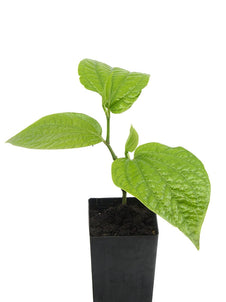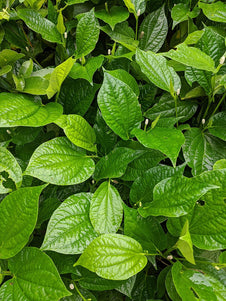

















Vegetable Pepper / Betel Leaf
Vegetable Pepper / Betel Leaf

- Low stock - 3 items left
- Inventory on the way

Usually available: October to April
Life cycle: Perennial
Height: 50cm
Position: Part shade
Soil preference: Well drained
This is how we pack and send your Herb Plants to all states except TAS & WA
You will receive
- 1 Vegetable Pepper / Betel Leaf Herb Plant in a 50 X 75mm tube - General growing instructions
All of our Herb Plants are grown organically with certified organic potting mixes and fertilizers
Botanical Name: Piper sarmentosum
Vegetable pepper is a perennial, creeping plant growing up to about 60cm. The leaves are dark green and glossy and oval-shaped with a pointed tip and have small white flowers that occur in little rounded spikes. It also goes by the names wild pepper, Cha plu in Thailand, La lot in Vietnam and various other names throughout Asia like the betel leaf plant. Although commonly called Betel leaves in Australia, we have always called it vegetable pepper to identify it from Betel pepper the leaves of which are chewed with lime and the fruit/nut from the betel palm.
Cooking
The leaves which have a spicy peppery taste can be cooked like spinach and used as a vegetable or can be shredded and added to soups stews and stir-fries at the end of cooking to give a subtle peppery flavour. Raw Vegetable Pepper leaves can also be torn or shredded into salads and are particularly nice in rice salad. The leaves are also used to wrap small pieces of food. In Thailand, cha plu is used to wrap raw ginger, peanuts, shrimps, shallots and lime to make delicious small snacks. The Vietnamese use la lot to wrap small amounts of minced meat, which are then fried in oil.
Try this recipe on our blog Spicy Chicken Salad on Betel leaves.
Medicinal Uses
A decoction of the leaves is used to treat coughs, flu, asthma, rheumatism, pleurisy and lumbago. The leaves are chewed for toothache.
Growing Conditions
Piper sarmentosum likes a warm spot in the shade with rich soil and good drainage. If you get cold winters it will die back a bit and go yellow, then come away again in warmer weather. it will not tolerate frost. It does spread easily so you may want to keep it in its own bed and trim it regularly.
All information provided on this website is for informational purposes only. Please seek professional advice before commencing any treatment.





